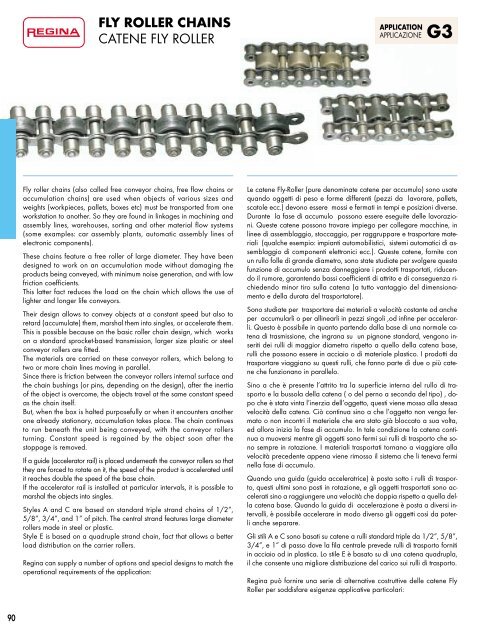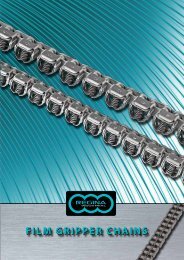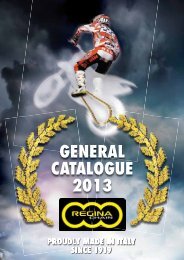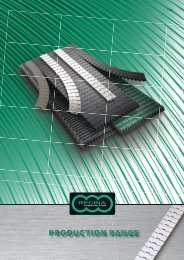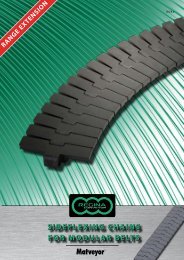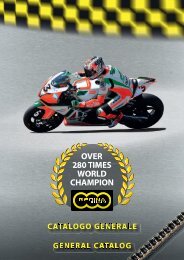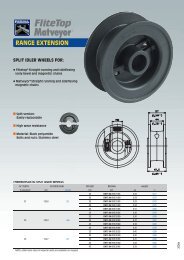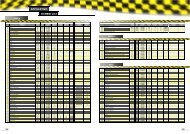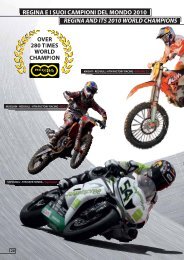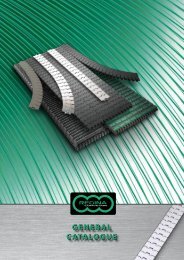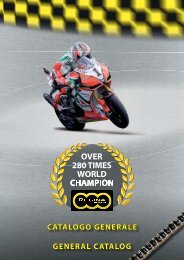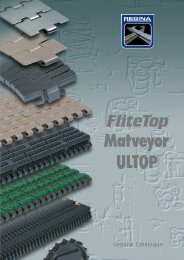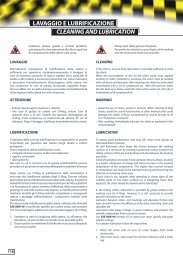Catalogo Generale Industrial - Regina
Catalogo Generale Industrial - Regina
Catalogo Generale Industrial - Regina
You also want an ePaper? Increase the reach of your titles
YUMPU automatically turns print PDFs into web optimized ePapers that Google loves.
FLY ROLLER CHAINSCATENE FLY ROLLERAPPLICATIONAPPLICAZIONE G3Fly roller chains (also called free conveyor chains, free flow chains oraccumulation chains) are used when objects of various sizes andweights (workpieces, pallets, boxes etc) must be transported from oneworkstation to another. So they are found in linkages in machining andassembly lines, warehouses, sorting and other material flow systems(some examples: car assembly plants, automatic assembly lines ofelectronic components).These chains feature a free roller of large diameter. They have beendesigned to work on an accumulation mode without damaging theproducts being conveyed, with minimum noise generation, and with lowfriction coefficients.This latter fact reduces the load on the chain which allows the use oflighter and longer life conveyors.Their design allows to convey objects at a constant speed but also toretard (accumulate) them, marshal them into singles, or accelerate them.This is possible because on the basic roller chain design, which workson a standard sprocket-based transmission, larger size plastic or steelconveyor rollers are fitted.The materials are carried on these conveyor rollers, which belong totwo or more chain lines moving in parallel.Since there is friction between the conveyor rollers internal surface andthe chain bushings (or pins, depending on the design), after the inertiaof the object is overcome, the objects travel at the same constant speedas the chain itself.But, when the box is halted purposefully or when it encounters anotherone already stationary, accumulation takes place. The chain continuesto run beneath the unit being conveyed, with the conveyor rollersturning. Constant speed is regained by the object soon after thestoppage is removed.If a guide (accelerator rail) is placed underneath the conveyor rollers so thatthey are forced to rotate on it, the speed of the product is accelerated untilit reaches double the speed of the base chain.If the accelerator rail is installed at particular intervals, it is possible tomarshal the objects into singles.Styles A and C are based on standard triple strand chains of 1/2”,5/8”, 3/4”, and 1” of pitch. The central strand features large diameterrollers made in steel or plastic.Style E is based on a quadruple strand chain, fact that allows a betterload distribution on the carrier rollers.<strong>Regina</strong> can supply a number of options and special designs to match theoperational requirements of the application:Le catene Fly-Roller (pure denominate catene per accumulo) sono usatequando oggetti di peso e forme differenti (pezzi da lavorare, pallets,scatole ecc.) devono essere mossi e fermati in tempi e posizioni diverse.Durante la fase di accumulo possono essere eseguite delle lavorazioni.Queste catene possono trovare impiego per collegare macchine, inlinee di assemblaggio, stoccaggio, per raggruppare e trasportare materiali(qualche esempio: impianti automobilistici, sistemi automatici di assemblaggiodi componenti elettronici ecc.). Queste catene, fornite conun rullo folle di grande diametro, sono state studiate per svolgere questafunzione di accumulo senza danneggiare i prodotti trasportati, riducendoil rumore, garantendo bassi coefficienti di attrito e di conseguenza richiedendominor tiro sulla catena (a tutto vantaggio del dimensionamentoe della durata del trasportatore).Sono studiate per trasportare dei materiali a velocità costante od ancheper accumularli o per allinearli in pezzi singoli ,od infine per accelerarli.Questo è possibile in quanto partendo dalla base di una normale catenadi trasmissione, che ingrana su un pignone standard, vengono inseritidei rulli di maggior diametro rispetto a quello della catena base,rulli che possono essere in acciaio o di materiale plastico. I prodotti datrasportare viaggiano su questi rulli, che fanno parte di due o più cateneche funzionano in parallelo.Sino a che è presente l’attrito tra la superficie interna del rullo di trasportoe la bussola della catena ( o del perno a seconda del tipo) , dopoche è stata vinta l’inerzia dell’oggetto, questi viene mosso alla stessavelocità della catena. Ciò continua sino a che l’oggetto non venga fermatoo non incontri il materiale che era stato già bloccato a sua volta,ed allora inizia la fase di accumulo. In tale condizione la catena continuaa muoversi mentre gli oggetti sono fermi sui rulli di trasporto che sonosempre in rotazione. I materiali trasportati tornano a viaggiare allavelocità precedente appena viene rimosso il sistema che li teneva ferminella fase di accumulo.Quando una guida (guida acceleratrice) è posta sotto i rulli di trasporto,questi ultimi sono posti in rotazione, e gli oggetti trasportati sono acceleratisino a raggiungere una velocità che doppia rispetto a quella dellacatena base. Quando la guida di accelerazione è posta a diversi intervalli,è possibile accelerare in modo diverso gli oggetti così da poterlianche separare.Gli stili A e C sono basati su catene a rulli standard triple da 1/2”, 5/8”,3/4”, e 1” di passo dove la fila centrale prevede rulli di trasporto fornitiin acciaio od in plastica. Lo stile E è basato su di una catena quadrupla,il che consente una migliore distribuzione del carico sui rulli di trasporto.<strong>Regina</strong> può fornire una serie di alternative costruttive delle catene FlyRoller per soddisfare esigenze applicative particolari:90


